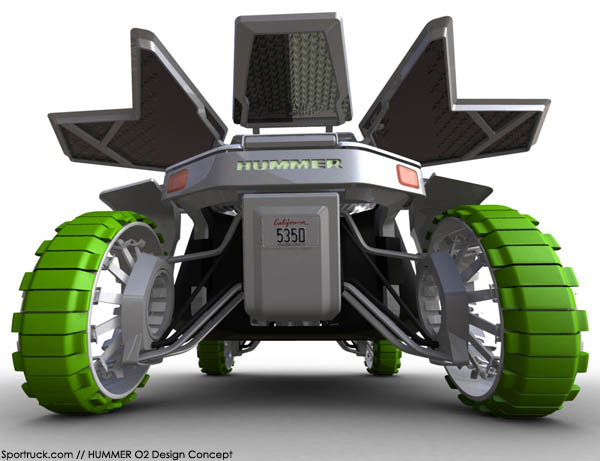HUMMER O2 Design
Concept
GM West Coast Advanced Design
Studio concept wins Design Challenge
December 1, 2006
What might automobiles look like 15 years in the
future? That is the question posed to Los Angeles automobile design
studios, representing almost every major automobile manufacturer. The
contest, called the Design Challenge, is part of a automobile design
conference featured at the LA Auto Show.
The Los Angeles area is home to 15 automobile manufacturers' design
studios, all within 120-mile radius of one another. This year nine of
those studios participated in the contest. Each of the design teams
was instructed to create a vehicle that is environmentally aware of
its global footprint. Each vehicle has technology to allow the public
to enjoy the distinctive Southern California lifestyle and unique
environment without harming it. The entries were judged on the
following criteria: originality of creative concept, contribution to
the environment, degree of safety and reflection of a unique, spirited
Southern California "green" lifestyle.
This year's winner is the HUMMER O2 Concept, an entry from General
Motors West Coast Advanced Design Studio in Hollywood, CA. Their
two-dimensional renderings were chosen by a panel consisting of
multi-discipline design professionals from the leading Art and Design
Schools from the area.
The contest required that vehicle entries be 100-percent recyclable
and have a lifespan of just 60 months. The HUMMER O2 concept took that
a step further, by producing a vehicle that produces a "net gain" for
the environment. The team drew upon inspiration from trends in green
architecture and the concept of minimizing an individual's "carbon
footprint."
The key to the HUMMER 02 Concept is a revolutionary phototropic body
shell that produces pure oxygen throughout the life of the vehicle.
Algae-filled body panels transform harmful carbon dioxide into pure
oxygen that is subsequently released back into the environment and
inside the vehicle.
"The panels essentially function as the 'leaves' of the HUMMER O2 and
effectively clean the air in the surrounding environment," said
Saucedo. "Used algae are recycled as biomass for the further
production of energy."
The flow of CO2 and oxygen is regulated by a two-way valve system ("Mistic
Devices") in the corner of each panel. These sophisticated devices
control and monitor the amount of CO2 and source nutrition needed for
the algae cultivation and optimize oxygen production and distribution.
A central aluminum "tree" creates a perfect hexagonal structure that
both protects the central hydrogen tank and supports the external
structural body panels. The stiff body panels transform the tree intro
a safe enclosed spaceframe taking care of side impact protection.
Front and rear caps connect the powertrain and suspension ("roots")
firmly to the "tree".
To help further reduce environmental impact, the HUMMER O2’s
construction specifies the use of 100-percent post-consumer materials,
including an aluminum frame, seats finished with Volatile Organic
Components-free (VOC-free) materials and glazing via PETE (similar to
everyday consumer packaging, such as soda bottles).
Four modular and self-contained fuel cells power the hydraulic motors
attached to each wheel. New water-based hydraulic fluid is used. The
hydrogen tank is found in an ideal central location for both safety
and structural purposes, becoming this way the literal and
metaphorical “heart” of the vehicle.
Active Tread tires provide low resistance on the highway while
allowing excellent off-road progress as their shape changes – adapting
to and protecting the soil.
"The HUMMER O2 epitomizes the ethos of the true Southern California
outdoors enthusiast with rugged capability, a 'tread lightly' contact
system and construction methods promoting safety, accessibility and
reusability," said Frank Saucedo, director, GM Advanced Design in
California . "Most vehicles in L.A. spend 95 percent of their time
outdoors subjected to sunlight, so why couldn’t a vehicle give back?"
The GM West Coast Advanced Design Studio also won the 2005 Design
Challenge competition with its GMC PAD Concept, a mobile urban loft
designed for the L.A. environment. You can view the contest entries at
the LA Auto Show, running now through December 10, 2006 at the LA
Convention Center.
|
